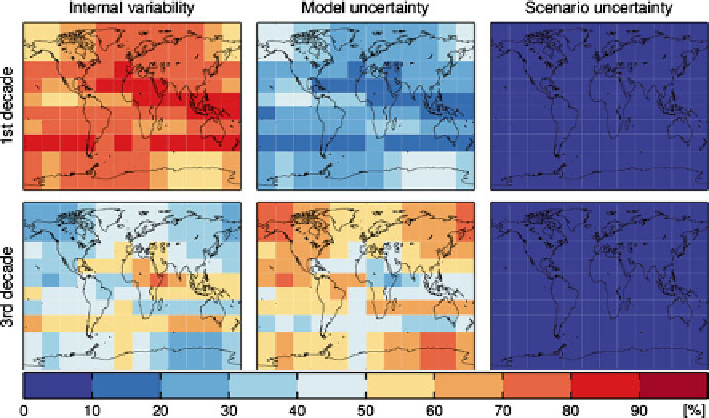Geoscience Reference
In-Depth Information
Fig. 16.5
Sources of uncertainty. Fraction of the variance explained by the three sources of uncer-
tainty in projections of decadal mean boreal winter (DJF) precipitation changes (Adapted from
Hawkins and Sutton
2011
)
Climate models provide average values for grid boxes that are typically tens or
even hundreds of kilometres in size, whereas users often require forecasts at specifi c
locations. Climate model output can be downscaled either statistically or with a
regional model forced at its boundaries by the global model forecasts. Dynamical
model forecasts can also potentially be improved by statistical post-processing. For
example, some models are able to predict ENSO, but not all of its remote impacts.
In this case, observed relationships may be used to infer forecasts of remote regions
from model ENSO predictions.
16.4
Current Capability
The likely skill of forecasts is usually assessed in historical tests known as hind-
casts. These are forecasts made retrospectively but only using observations that
would have been available at the start of each forecast. Skill is assessed by compar-
ing the hindcasts with the subsequent observations (e.g. Goddard et al.
2012
), and
may be quantifi ed using both deterministic measures of the ensemble mean (such as
correlation or mean squared error) and probabilistic measures based on individual
ensemble members (such as reliability, Corti et al.
2012
).
Decadal predictions are much less mature than seasonal forecasts. Several early
studies with individual models showed improved skill through initialization (Smith
et al.
2007
; Keenlyside et al.
2008
; Pohlmann et al.
2009
; Mochizuki et al.
2009
;
Smith et al.
2010
), prompting the development of a coordinated protocol (CMIP5,
Taylor et al.
2012
) enabling a more robust multi-model assessment. Initial CMIP5

Search WWH ::

Custom Search